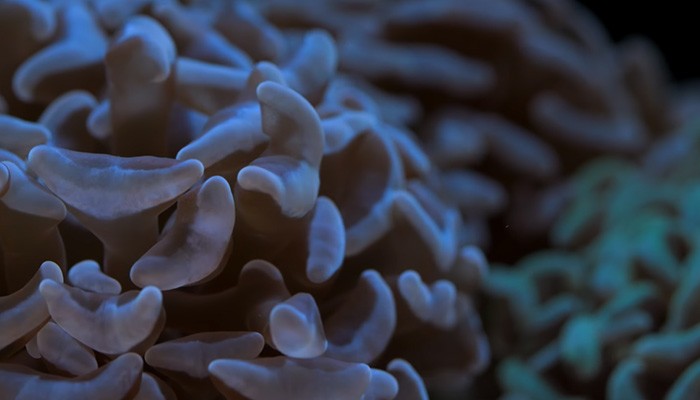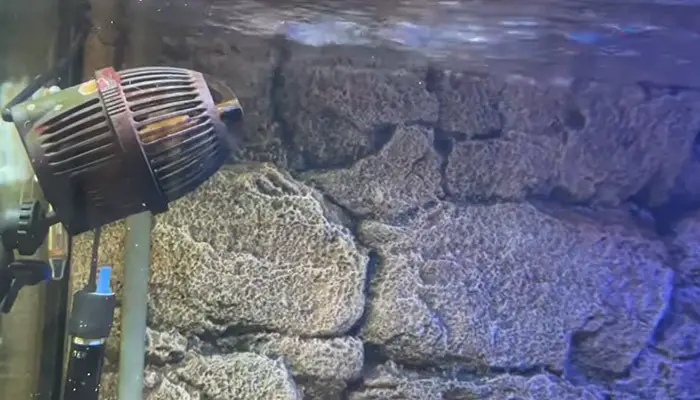6 Reasons for Hammer Coral Losing Color [How to Revive]
With a wide range of available colors and striking appearance, Hammer Corals are certainly the true slayers in your aquarium. They are a treat to your eyes until you realize your Hammer Coral is losing color!
Well, losing color is very common for most large polyp stony corals. And many aquarists are actually found to complain mostly about their Euphyllia ancora known as Hammer Corals losing their glaze.
Of course, you want your precious Hammer Coral to look beautiful and colorful as always.
However, now that you are worried about your corals and wondering why they are losing their vibrant hues, let us help you with the possible reasons for it.
There could be a number of causes. But the main reasons include light intensity, water temperature, alkalinity, higher amounts of chemical components, and others.
Let’s talk elaborately and tell you how to get rid of this problem as well.
| Reasons | Quick Fixes |
| Excessive or Insufficient Light | Ensure the moderate light level |
| Water alkalinity | Obtain 8 to 11 dkH |
| Water Temperature | Obtain 22.2-25.5 degrees Celsius |
| Chemical Components | Obtain optimum calcium and magnesium level |
| Water Flow and Placement | Moderate water flow |
| Pests and Diseases | Change tank water |
Hammer Coral Losing Color-Causes and Solution

1. Excessive or Insufficient Light
Determining the true color of any coral is highly dependent on the light intensity. Light is surely one of the greatest factors affecting their color. Nonetheless, Hammer Coral’s best works under low lighting.
Low light brings the perfect hue and appearance that you want to look for in your Hammer Coral. Generally, corals carry zooxanthellae in them which are actually microscopic algae. The algae use light to produce food.
Feeding themselves from the light, the algae provide visual pigment to the Hammer Corals as well. Nonetheless, there are different types and species of zooxanthellae available and they require different intensities of light.
Moreover, Hammer Corals are likely to expand their polyps longer when there is low light intensity. However, too much light intensity can kill the algae inside the coral. Consequently, the algae leave the coral making it bleached white.
Control Measure
- Always ensure a moderate light level of 50 to 150 PAR. This light intensity will allow the algae to run the photosynthesis process and make food. The light level also ensures a healthy rate of photosynthesis.
- Also, you can use moonlight to create a neon glow to get the best hue of your favorite Hammer Coral.
- If you want your Hammer Coral to adjust with the light intensity properly then you can use screening materials. Set them at several layers between the light source and the reef tank.
- Sometimes reducing the photoperiod lengths helps to heal the photo shock your Hammer Coral might be going through.
Again, you should consider the placement of the aquarium light. Only the right placement can offer the healthy process of photosynthesis to the algae.
2. Water Alkalinity
If everything is okay in your tank but still your Hammer Coral is losing its color then it is surely because of the low water alkalinity. Not only Hammer Corals but also other reef corals love to slay in slightly alkaline soil.
Once the pH drops and the tank water becomes acidic. Consequently, the Hammer Coral will show symptoms of losing color. Therefore, maintaining alkalinity is one of the most important jobs to do. It is one of the tank water parameters that has to be ensured.
Lower alkalinity spurs bleaching of Hammer Corals even though you manage to set the proper light intensity. Hence, if the tank has less or more than the required alkalinity level then your Hammer Corals might even die after bleaching.
It is simply because lower alkalinity becomes lethargic to the Hammer Corals. Moreover, alkalinity levels can also be affected by other chemical levels in the tank water.
Control Measure
- Frequently monitor and assess the alkalinity level in the tank water where you have placed your Hammer Corals.
- Make sure the alkalinity level always remains between 8 to 11 dkH.
- Measure the pH value of the water with the help of a pH meter and work accordingly. Make sure the tank has a pH range between 8.1 to 8.3.
- Again, do not forget to check other chemical levels in the tank water as well. If you find the concentration is low then increase it instantly.
So, as you can see alkalinity matters a lot and its lower level can bleach out the hammer coral, you better maintain it.
3. Water Temperature
Water temperature is another parameter that has to be ensured to protect your Hammer Coral from not losing its color. It happens when the temperatures of the water are too high. In such a situation, the reef corals suffer from mass bleaching.
Therefore, water temperature matters a lot when it comes to sustaining the vibrant hue of your corals. Moreover, if the temperature goes too high then there are chances it will kill the zooxanthellae algae and remove it from the coral.
Furthermore, high temperatures will leave the exoskeleton of your Hammer Coral in the end. As a result, there will be no way the coral will retain its previous hue.
Control Measure
- Keep on checking the water temperature of the tank. The temperatures should be between 72 to 78 degrees Fahrenheit or 22.2 to 25.5 degrees Celsius.
- Never let any components intrude into the tank water that can make the water temperatures higher.
- Again, lower temperatures can also affect the color of your Hammer Corals. So, you have to obtain the optimum temperatures.
4. Chemical Components
Another reason for your Hammer Corals to lose their color is excessive exposure to some specific chemical components. Your tank water might require several chemical components to create an environment.
However, to let you know, the overabundance of exposure to phosphates and nitrates causes the bleaching of Hammer Corals. These chemicals are basically byproducts or waste of other organisms in the tank like fish.
These chemicals are also considered toxins. If the tank water contains nitrates of more than 10 ppm, then it will surely be a problem. If the nitrate level goes to the 30 to 40 ppm range then the Hammer Coral will start to lose its tissues.
As a result, you will discover them bleaching slowly. Moreover, the toxins float around the tank water and eventually come in touch with the Hammer Corals. Consequently, they attack the zooxanthellae and turn them unnatural in color.
Furthermore, the algae become brown in color and look ugly. Again, the saltwater aquarium requires some specific components for making the proper environment.
Among them, magnesium and calcium are the most crucial components. But again, an excessive amount or level can affect diversely to the coral making it lose its vibrant color.
Control Measure
- To get rid of the toxins and byproducts, water change in the aquarium can help. Change the water frequently to keep the chemicals and toxins under control.
- Do not allow any toxin to enter the tank water in any way.
- Keep measuring the nitrate and phosphate levels in the water. If the rate rises exceeding the safe level, immediately take action and change the water.
- Also, keep inspecting and measuring the magnesium and calcium levels in the tank water as well.
- The magnesium level should remain between 1200 to 1350 ppm. Whereas, the calcium level should remain between 350 to 450 ppm.
Therefore, to protect your hammer color from losing its color, you have to ensure the proper rate of chemical components.
5. Water Flow and Placement

Water flow is also one of the most important factors that affect the growth rate and coloration of Hammer Corals. High water flow will bleach the coral color in no time. In some cases, it might interrupt the easy movement of corals.
Moreover, high water flow affects the polyps and coral tissues as well. Consequently, Hammer Coral starts to lose its color. Even the polyps may tear making the coral white.
Water flow and placement of Hammer Corals are interrelated. Lighting, however, also comes in between. If you fail to keep your Hammer Coral in the right place then it will affect the coral color for sure.
However, corals are not that picky about their placement. They can survive almost anywhere even on sand. But it is threatening to them when something gets stuck to their polyps. They start reacting and sometimes start losing color.
Control Measure
- Like fixing moderate light in your tank, you must also ensure moderate water flow. Hammer Corals are likely to offer the best view when the water flow is medium.
- Again, to balance tank water flows you can use a wavemaker or powerhead (our pick: FREESEA Aquarium Circulation Pump Wave Maker Power Head with magnetic mount Suction).
- Let your Hammer Coral stretch as much as it wants. It will help the coral endure the pigment very well.
6. Pests and Diseases
Hammer Corals are resistant to diseases. Yet, they can be affected and lose colors eventually. Some organisms like brown flatworms or acoel worms can enter the tank and attack the coral.
Once these worms attack your Hammer Coral, first they destroy the tissue and then affect its hue. Even the worms can kill the Hammer Coral as well.
Again, your coral can have brown jelly infections that can also be a reason for losing color. If not treated well, then your Hammer Corals may die eventually.
Control Measure
- Since you can see the worms bear eyes, eradicate them as soon as you discover them. Moreover, egg masses are also visible in the water. Thus, frequently check the water so that no pests or worms can enter and reproduce in the tank water.
- Seal every possibility of entering the pests and worms into the tank water where you have placed your Hammer Coral.
- Change the tank water frequently. Sometimes it is the water that encourages infections in Hammer Corals.
So, these are some common and possible reasons why your Hammer Coral is losing color.
Read More-
FAQs
Can Hammer Coral Recover?
Once Hammer Coral bleach there is almost zero chance it will recover. However, Hammer Corals are tough survivors. They will survive any situation and also will keep expanding their polyps unconditionally.
Why Is My Hammer Coral Bleaching?
The main reason is your Hammer Coral must be stressing over something. Once the zooxanthellae algae feel an interruption in its photosynthesis process, Hammer Coral starts bleaching.
How Do You Know If Hammer Coral Is Dying?
If a coral is dying, it will show certain symptoms like losing color or bleaching, deformation, being covered in algae, and all.
Final Words
Now that you know the reasons for Hammer Coral losing its color, you should find out what is the specific reason in your tank.
Inspect the tank very well and then follow the control measures we have provided above. Hopefully, you will be able to protect your coral from bleaching or losing its beautiful hue.
Remember that Hammer Corals are precious and they need attention. So, provide them with enough care and ensure the right water parameters.
So, if our article was helpful enough then let us know through your feedback. We will try to answer your queries as well.
- 7 Reasons For Anubias Leaves Turning Yellow [Solution] - February 3, 2024
- Types & Sizes Of Aquarium Explained: Guide To Pick The Best One - January 27, 2024
- 15 Best Carpeting Plants For Aquascaping -Beginner’s Pick - January 11, 2024

